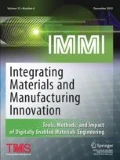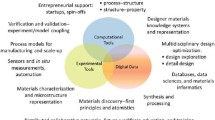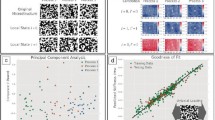Abstract
Materials data management, analytics, and e-collaborations have been identified as three of the main technological gaps currently hindering the realization of the accelerated development and deployment of advanced materials targeted by the federal materials genome initiative. In this paper, we present our ongoing efforts aimed at addressing these critical gaps through the customized design and build of suitable data infrastructure elements. Specifically, our solutions include: (1) ELA—an experimental and laboratory automation software platform that systematically tracks interrelationships between the heterogeneous experimental datasets (i.e., provenance) acquired from diverse sample preparation and materials characterization equipment in a single consistent metadata database, (2) PyMKS—the first Python-based open-source materials data analytics framework that can be used to create high-fidelity, reduced-order (i.e., low computational cost), process–structure–property linkages for a broad range of material systems with a rich hierarchy of internal structures spanning multiple length scales, and (3) MATIN—a HUBzero-based software platform aimed at nucleating an emergent e-science community at the intersection of materials science, manufacturing, and computer science, and facilitating highly productive digital collaborations among geographically and organizationally distributed materials innovation stakeholders. This paper provides a timely report of lessons learned from these interrelated efforts.










Similar content being viewed by others
References
National Science and Technology Council (2011) Materials genome initiative for global competitiveness
Olson GB, Kuehmann CJ (2014) Materials genomics: from CALPHAD to flight. Scr Mater 70:25–30
McDowell DL, Olson GB (2008) Concurrent design of hierarchical materials and structures. Sci Model Simul 15:207–240
Hao S et al (2003) A hierarchical multi-physics model for design of high toughness steels. J Comput Aided Mater Des 10:99–142
Olson GB (2006) Advances in theory: martensite by design. Mater Sci Eng, A 438:48–54
Adams BL, Kalidindi SR, Fullwood DT (2012) Microstructure sensitive design for performance optimization. Elsevier, Oxford
Fullwood DT et al (2010) Microstructure sensitive design for performance optimization. Prog Mater Sci 55(6):477–562
TMS (2017) Building a materials data infrastructure: opening new pathways to discovery and innovation in science and engineering. TMS, Pittsburgh, p xxvi,72
McDowell DL, Kalidindi SR (2016) The materials innovation ecosystem: a key enabler for the materials genome initiative. MRS Bull 41(04):326–337
Kalidindi SR (2015) Data science and cyberinfrastructure: critical enablers for accelerated development of hierarchical materials. Int Mater Rev 60(3):150–168
Kalidindi SR, Medford AJ, McDowell DL (2016) Vision for data and informatics in the future materials innovation ecosystem. JOM 68(8):2126–2137
Kalidindi SR, Graef MD (2015) Materials data science: current status and future outlook. Annu Rev Mater Res 45:171–193
O’Mara J, Meredig B, Michel K (2016) Materials data infrastructure: a case study of the citrination platform to examine data import, storage, and access. JOM 68(8):2031–2034
Dima A et al (2016) Informatics infrastructure for the materials genome initiative. JOM 68(8):2053–2064
Jain A, Persson KA, Ceder G (2016) Research update: the materials genome initiative: data sharing and the impact of collaborative ab initio databases. APL Mater 4(5):053102
Pfeif EA, Kroenlein K (2016) Perspective: data infrastructure for high throughput materials discovery. APL Mater 4(5):053203
Wilkinson MD, et al (2016) The FAIR guiding principles for scientific data management and stewardship. Sci Data 3:160018
International DOI Foundation (IDF) (2018) Available from: https://www.doi.org/
HDL.NET® Information Services (2019) Available from: http://handle.net/
Dieter GE (ed) (1997) Materials selection and design. Cleveland, ASM International
Ashby MF, Greer AL (2006) Metallic glasses as structural materials. Scr Mater 54(3):321–326
Cahn RW, Haasen P (1996) Physical metallurgy. Elsevier, Oxford
Olson GB (2000) Designing a new material world. Science 288(5468):993
Olson GB (1997) Computational design of hierarchically structured materials. Science 277(29):1237–1242
Olson GB (1997) Systems design of hierarchically structured materials: advanced steels. J Comput-Aided Mater Des 4:143–156
McDowell DL et al (2009) Integrated design of multiscale, multifunctional materials and products. Elsevier, Oxford
Kalidindi SR (2015) Hierarchical materials informatics. Butterworth Heinemann, Oxford
Gomberg JA, Medford AJ, Kalidindi SR (2017) Extracting knowledge from molecular mechanics simulations of grain boundaries using machine learning. Acta Mater. 133(Supplement C):100–108
PRedictive Integrated Structural Materials Science (PRISMS). http://www.prisms-center.org/#/home
Materials Data Curation System (MDCS). https://mdcs.nist.gov/
Blaiszik B et al (2016) The materials data facility: data services to advance materials science research. JOM 68(8):2045–2052
The Materials Data Facility (MDF) (2019). https://materialsdatafacility.org/
Figshare. https://figshare.com
The Material Data Management Consortium (MDMC). www.mdmc.net
The Materials Experiment and Analysis Database (MEAD). https://solarfuelshub.org/materials-experiment-andanalysis-database
NREL Energy DataBUS. http://www.nrel.gov/analysis/databus/
Pendleton IM et al (2019) Experiment specification, capture and laboratory automation technology (ESCALATE): a software pipeline for automated chemical experimentation and data management. MRS Commun 2:1–14
Dryad Digital Repository (2019). https://datadryad.org
Vogt H (2002) Efficient object identification with passive RFID tags. In: International conference on pervasive computing. Springer
National Institute of Standards and Technology, G. Maryland. NIST schema repository and registry. https://schemas.nist.gov/
Garcia L, et al (2017) Bioschemas: schema.org for the life sciences. proceedings of SWAT4LS
Brough DB, Wheeler D, Kalidindi SR (2017) Materials knowledge systems in Python—a data science framework for accelerated development of hierarchical materials. Integr Mater Manuf Innov 6:36–53
The Materials Project. https://materialsproject.org
JARVIS (Joint Automated Repository for Various Integrated Simulations). https://jarvis.nist.gov/
The Novel Materials Discovery (NOMAD) Laboratory. https://nomad-coe.eu/
Torquato S (2013) Random heterogeneous materials: microstructure and macroscopic properties, vol 16. Springer, Berlin
Brough DB, Wheeler D, Kalidindi SR (2017) Materials knowledge systems in python—a data science framework for accelerated development of hierarchical materials. Integr Mater Manuf Innov 6(1):36–53
Kalidindi SR et al (2015) Application of data science tools to quantify and distinguish between structures and models in molecular dynamics datasets. Nanotechnology 26(34):344006
Brough DB et al (2017) Extraction of process-structure evolution linkages from X-ray scattering measurements using dimensionality reduction and time series analysis. Integr Mater Manuf Innov 6(2):147–159
Brough DB et al (2017) Microstructure-based knowledge systems for capturing process-structure evolution linkages. Curr Opin Solid State Mater Sci 21(3):129–140
Popova E et al (2017) Process-structure linkages using a data science approach: application to simulated additive manufacturing data. Integr Mater Manuf Innov 6(1):54–68
Paulson NH et al (2017) Reduced-order structure-property linkages for polycrystalline microstructures based on 2-point statistics. Acta Mater 129:428–438
GitHub (2019). https://github.com/
Conda-Forge (2019). https://conda-forge.org/
Wheeler D, Brough DB (2017) PyMKS. http://pymks.org
Kowalczyk K, Gambin W (2004) Model of plastic anisotropy evolution with texture-dependent yield surface. Int J Plast 20(1):19–54
Team DD (2016) Dask: library for dynamic task scheduling. https://dask.org/
Wheeler D, Brough DB (2017) PyMKS examples. http://pymks.org/en/latest/rst/index.html
CI C (2019) Circle CI tutorials and sample apps. https://circleci.com/docs/2.0/tutorials/
Travis C (2018) Test and deploy your code with confidence. https://travis-ci.org/
Pedregosa F et al (2011) Scikit-learn: machine learning in python. J Mach Learn Res. 12:2825–2830
Materials Innovation Network (MATIN) (2019). https://matin.gatech.edu
HUBzero. [cited 2016 March 6]. https://hubzero.org/
Galaxy Project (2019). https://mygeohub.org/groups/gabbs/aboutidata
Globus (2019). https://www.globus.org/
iData—Data Management with Geospatial and Metadata Support (2019). https://mygeohub.org/groups/gabbs/aboutidata
The geospatial data analysis building blocks (GABBs) (2019). https://mygeohub.org/groups/gabbs/
Zhao L. et al. (2017) GABBs-reusable geospatial data analysis building blocks for science gateways. In: IWSG
gUSE grid and cloud science gateway (2019). https://sourceforge.net/projects/guse/
Apache Airavata (2016). https://airavata.apache.org/
Open Science Framework (OSF) (2019). https://osf.io/
CyVerse (2019). https://www.cyverse.org/
Goff SA et al (2011) The iPlant collaborative: cyberinfrastructure for plant biology. Front Plant Sci 2:34
Merchant N et al (2016) The iPlant collaborative: cyberinfrastructure for enabling data to discovery for the life sciences. PLoS Bio 14(1):e1002342
Partnership for an Advanced Computing Environment (PACE) (2019). https://pace.gatech.edu/
The Extreme Science and Engineering Discovery Environment (XSEDE). (2018). https://www.xsede.org/
The Center for Materials Design Development and Deployment (MD3) (2019). https://md3.gatech.edu/
Robo-Met Materials Characterization. https://www.ues.com/robomet
Autonomous Materials Discovery (AiMade). http://www.aimade.org/
ADA (2019). http://www.projectada.ca/
Nikolaev P et al (2016) Autonomy in materials research: a case study in carbon nanotube growth. Comput Mater 2(1):16031
Maruyama B, et al (2017) Autonomous experimentation applied to carbon nanotube synthesis. In: Meeting abstracts. The Electrochemical Society
Granda JM et al (2018) Controlling an organic synthesis robot with machine learning to search for new reactivity. Nature 559(7714):377–381
Steiner S et al (2019) Organic synthesis in a modular robotic system driven by a chemical programming language. Science 363(6423):eaav2211
Fitzpatrick DE, Battilocchio C, Ley SV (2016) A novel internet-based reaction monitoring, control and autonomous self-optimization platform for chemical synthesis. Org Process Res Dev 20(2):386–394
Cortés-Borda D et al (2018) An autonomous self-optimizing flow reactor for the synthesis of natural product carpanone. J Org Chem 83(23):14286–14299
Henson AB, Gromski PS, Cronin L (2018) Designing algorithms to aid discovery by chemical Robots. ACS Central Sci 4(7):793–804
Dragone V et al (2017) An autonomous organic reaction search engine for chemical reactivity. Nat Commun 8(1):15733
Kalidindi SR, Pathak S (2008) Determination of the effective zero-point and the extraction of spherical nanoindentation stress–strain curves. Acta Mater 56(14):3523–3532
Pathak S, Shaffer J, Kalidindi SR (2009) Determination of an effective zero-point and extraction of indentation stress–strain curves without the continuous stiffness measurement signal. Scr Mater 60(6):439–442
Hofmann DC et al (2014) Developing gradient metal alloys through radial deposition additive manufacturing. Sci Rep 4:5357
Zhang Y et al (2008) Characterization of laser powder deposited Ti–TiC composites and functional gradient materials. J Mater Process Technol 206(1):438–444
Bobbio LD et al (2017) Additive manufacturing of a functionally graded material from Ti–6Al–4 V to Invar: experimental characterization and thermodynamic calculations. Acta Mater 127:133–142
Qian T-T et al (2014) Microstructure of TA2/TA15 graded structural material by laser additive manufacturing process. Trans Nonferrous Met Soc China 24(9):2729–2736
Gu DD et al (2012) Laser additive manufacturing of metallic components: materials, processes and mechanisms. Int Mater Rev 57(3):133–164
Zuback JS, Palmer TA, DebRoy T (2019) Additive manufacturing of functionally graded transition joints between ferritic and austenitic alloys. J Alloy Compd 770:995–1003
Khosravani A, Cecen A, Kalidindi SR (2017) Development of high throughput assays for establishing process-structure-property linkages in multiphase polycrystalline metals: application to dual-phase steels. Acta Mater 123:55–69
Weaver JS et al (2016) On capturing the grain-scale elastic and plastic anisotropy of alpha-Ti with spherical nanoindentation and electron back-scattered diffraction. Acta Mater 117:23–34
Iskakov A et al (2018) Application of spherical indentation and the materials knowledge system framework to establishing microstructure-yield strength linkages from carbon steel scoops excised from high-temperature exposed components. Acta Mater 144:758–767
ASTM E8 / E8M-15a (2015) Standard Test Methods for Tension Testing of Metallic Materials. ASTM International, West Conshohocken, PA. https://www.astm.org
Standard Test Methods of Compression Testing of Metallic Materials at Room Temperature (2009). ASTM International
Standard Test Methods for Bend Testing of Metallic Flat Materials for Spring Applications Involving Static Loading (2013). ASTM International
Standard Test Method for Shear Modulus at Room Temperature. 2013, ASTM International
Kalidindi SR (2019) A Bayesian framework for materials knowledge systems. MRS Commun 9(2):518–531
Xue D et al (2016) Accelerated search for materials with targeted properties by adaptive design. Nat Commun 7:11241
Balachandran PV et al (2016) Adaptive strategies for materials design using uncertainties. Sci Rep 6:19660
Kiyohara S et al (2016) Acceleration of stable interface structure searching using a kriging approach. Jpn J Appl Phys 55(4):045502
Seko A et al (2014) Machine learning with systematic density-functional theory calculations: Application to melting temperatures of single-and binary-component solids. Phys Rev B 89(5):054303
Seko A et al (2015) Prediction of low-thermal-conductivity compounds with first-principles anharmonic lattice-dynamics calculations and Bayesian optimization. Phys Rev Lett 115(20):205901
Wigley PB et al (2016) Fast machine-learning online optimization of ultra-cold-atom experiments. Sci Rep 6:25890
Ueno T et al (2016) COMBO: an efficient Bayesian optimization library for materials science. Mater Discov 4:18–21
Acknowledgements
The authors acknowledge support for this work from NIST 70NANB18H039 (Program Manager: Dr. James Warren). MATIN platform was developed with support from GT’s IMAT and Office of Executive Vice-President for Research.
Author information
Authors and Affiliations
Corresponding author
Ethics declarations
Conflict of interest
The authors declare that they have no conflict of interest.
Rights and permissions
About this article
Cite this article
Kalidindi, S.R., Khosravani, A., Yucel, B. et al. Data Infrastructure Elements in Support of Accelerated Materials Innovation: ELA, PyMKS, and MATIN. Integr Mater Manuf Innov 8, 441–454 (2019). https://doi.org/10.1007/s40192-019-00156-1
Received:
Accepted:
Published:
Issue Date:
DOI: https://doi.org/10.1007/s40192-019-00156-1




